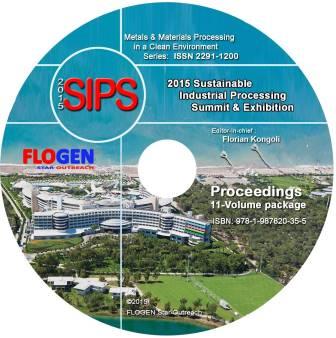2015-Sustainable Industrial Processing Summit
SIPS 2015 Volume 6: Coatings, Cement, Rare Earth & Ferro-alloys
| Editors: | Kongoli F, Yildirim H, Hainer S, Hofmann K, Proske T, Graubner C.A., Albert B |
| Publisher: | Flogen Star OUTREACH |
| Publication date: | 23 December 2015 |
| Pages: | 200 pages |
| ISBN: | 978-1-987820-29-4 |
| ISSN: | 2291-1227 (Metals and Materials Processing in a Clean Environment Series) |

< CD shopping page
Compositional Characterization of Secondary Copper Anodes Obtained from Aqueous Residues of PM and PGM Refining Processes
Nurten Deva1; Musa Rizaj2; Ismail Duman3; Florian Kongoli4;1PUBLIC UNIVERSITY OF MITROVICE - ISA BOLETINI - , FACULTY OF GEOSCIENCES, REPUBLIC OF KOSOVA, Mitrovice, Kosovo; 2UNIVERSITY OF PRISHTINA, Prishtina, Kosovo; 3ISTANBUL TECHNICAL UNIVERSITY, Istanbul, Turkey; 4FLOGEN TECHNOLOGIES INC., Mont-Royal, Canada;
Type of Paper: Plenary
Id Paper: 110
Topic: 11
Abstract:
The refining processes of precious and platinum group metals generate large volumes of aqueous residues that contain considerable concentration levels of copper (Cu), gold (Au), silver (Ag), platinum (Pt), Palladium (Pd), Iridium ( Ir ) and other platinum group metals. One possible treatment of these residues is their use in the production of secondary copper anodes (SCA) which in turn can be used in electrolytic refining processes to separate PM, PGM and other elements that these SCA contains.
This work, which is part of a bigger study on separation of Au, Ag, Pt, Pd and Ir from anode slime gained from secondary copper, describes a compositional characterization of secondary copper anodes obtained from various aqueous residues. It was found that SCA contains Cu, PMs, PGM and some other recoverable metals such as nickel, selenium and tellurium. The composition of the secondary copper anodes differs from the composition of the primary Cu anode. Although SCA contains less precious metals and PGM compared to primary Cu anodes, they still have enough market economic value that justifies refining of these anodes and finding effective methods for extraction of these valuable metals from them. One of this method is electrolytic refining process that is based on differentiated behavior during electrolysis of each impurity found in this study.
Keywords:
secondary copper anodes; residues; waste waters; composition; precious metals; platinum group of metalsReferences:
[1] N. Deva, Experimental Research of separation of Au, Ag, Pt, Pd and Ir from anode slime gained from secondary copper, PhD Thesis, University of Pristina, Kosovo, 2013[2] Rylan S. Dobson, Joanna E. Burgess, Biological treatment of precious metal refinery wastewater, Minerals Engineering 20 (2007) 519–532
[3] C. Wenzl, A. Filzwieser, H. Antrekowitch, Review of anode casting –Part II: Physical anode quality, World of Metallurgy –Erzmetall, 60 (2007) No.2
[4] U.U. Jadhav, H. Hocheng, A review of recovery of metals from industrial waste, Department of Power Mechanical Engineering, National Tsing Hua University, No. 101, Sec. 2, AMME Volume 54, Issue 2, October 2012,
[5] S. Syed, A green technology for recovery of gold from non-metallic secondary sources, Hydrometallurgy 82 (2006) 48-53